DIY patent registration
Background
Patenting process:
To protect your invention internationally:
- Conduct a patent search.
- File a provisional patent – use this guide to prepare and file the application yourself.
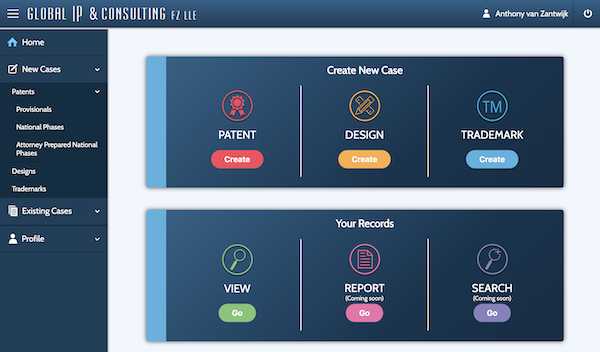
Either file a South African patent through GlobalIPCo for $199 or through Iptica for $99, and get a Patent Pending Number in 1 day.
- File an international PCT patent within 12 months of filing your provisional patent.
- File national phase / complete patents in countries where you wish to secure patents within 30 months of filing your provisional patent – typical filing cost: R25,000-R60,000 per country; typical prosecution cost: R25,000-R70,000 per country over the following 2-3 year.
Patent search:
Search the databases to identify the “new features” of your invention. To be “new”, the “feature” must not have been disclosed in any manner (verbally, in writing, by sale, etc.) anywhere in the world.
Provisional patent:
A provisional patent sets a date (the priority date) on which the novelty of a subsequently filed complete patent is determined. The provisional patent affords you a year: to develop your invention; disclose your invention freely to investors; conduct market and manufacturing research; and ultimately incorporate resultant improvements into the subsequently filed complete patent application.
You may file provisional patents online through Iptica or through GlobalIPCo using our Provisional patent template
PCT patent:
The PCT system is a filing system. The PCT patent application does not itself result in an “international patent”. Within 4 months of filing a PCT patent, you will receive a search report. And, at 30 months from the priority date (i.e. the filing date of your provisional patent), you must file national phase patents. See the GlobalIPCo online national phase patent filing system.
National phase / complete patents:
Once granted, a complete patent gives you a 20 year monopoly in that country – preventing others from making, using, exercising, selling, advertising and importing the patented product.
Complete patents must be filed by a patent attorney.
Drafting and filing a provisional patent for $99 (Iptica) or $199 (GlobalIPCo)
Now that you have decided to file a provisional patent, can you really do so without the assistance of a patent attorney? On average, more than 50% of South African provisional patents, representing approximately 2,500 applications per year, are filed directly by inventors. But, before taking the plunge, you need to understand a few basic concepts:
The legal requirements for a provisional patent are few. Basically, it need only describe comprehensively the features ultimately claimed in the subsequently filed complete patent.
In practice, a provisional patent specification includes the following sections: Title; Background of the Invention; Summary of the Invention; Brief Description of the Drawings; Detailed Description of the Drawings; and a set of drawings. Our guide aims to assist in preparing the specification, providing a skeleton to which you merely add the flesh.
It may be comforting to note that when drafting the corresponding complete patent, you may substitute drawings and revise the wording of the Claims / Summary. As long as the invention has been described comprehensively in the Detailed Description of the Drawings, most defects in the provisional patent (excluding insufficient disclosure) can be remedied in the complete patent.
Although a provisional patent does not require a set of claims, preparing this section assists in focusing the mind on the new, essential features of the invention, which must be described in detail. A search should assist in identifying / confirming these features. As a preliminary step, we suggest that you list the novel features of the invention and rank them according to essentiality. Thereafter, you can draft a set of claims that introduce these features one at a time. When introducing features, start by referring to the broadest possible category (e.g. fastener means), then reduce the scope of the categories (e.g. screws, nails, rivets, etc) until you finally arrive at the preferred feature (e.g. a flat-top screw).
Our Patents Act does not prescribe a format for drawings accompanying a provisional patent. Rough sketches or CAD drawings (on A4 pages) are sufficient, provided that they illustrate all features (including practical alternatives) described in the Detailed Description of the Drawings.
Once you have completed drafting the provisional patent specification, you must: sign the specification at the end of the Description; complete (in black ink and block letters) and attach forms prepared by GlobalIPCo’s online filing system; and file your application through the Iptica or GlobalIPCo systems (making payment by credit card).
Now that your provisional patent has been filed, you have 12 months to conduct market surveys and set up manufacturing facilities, or to sell the concept to potential licensees. In 12 months’ time, you must file either a complete patent in South Africa only or an international patent (PCT patent). In the meantime, do not: focus on “perfecting” – the product does not need to be perfect to attract investors; focus solely on obtaining government grants or VC funding; or duplicate manufacturing and marketing facilities that are expensive and time-consuming to set up and that are otherwise relatively easily accessed by licensing the technology.
HOW TO FILE A PROVISIONAL PATENT THROUGH GLOBALIPCO
Step 1: Register with GlobalIPCo and verify your email address by clicking on the link in the email that is sent to you.
Step 2: Select – New Cases; South Africa; Patent; Provisional.
Step 3: Enter your reference (this can be anything you wish to call it) and the title of your invention (e.g. “Car”).
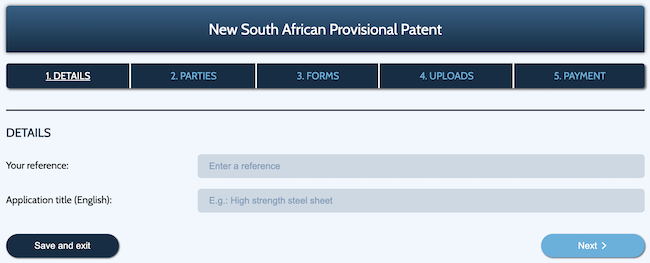
Step 4: Enter the applicant’s / owners’s name and physical address (not a postal address). If you are a company, select “Legal Entity”, otherwise, select “Natural Person”. Then, add the inventor’s name and country of residence.
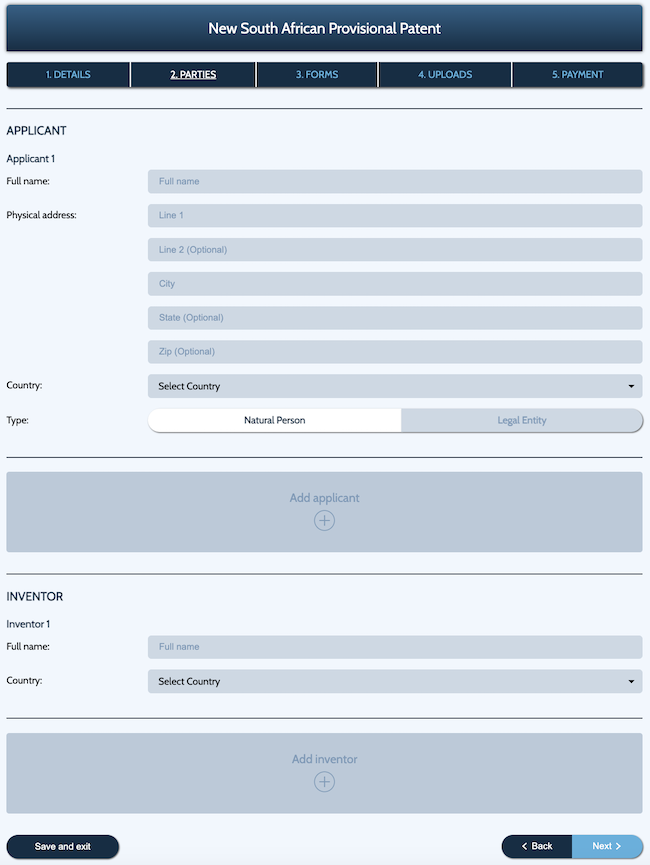
Step 5: Download the pre-populated forms for signature. Don’t make any changes to the forms. Simply sign them and scan the signed forms.
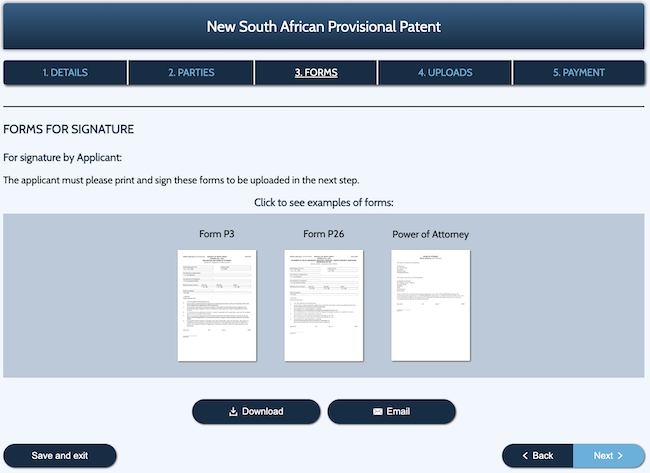
Step 6: Upload the signed forms, a copy of your patent specification (see the guide below for tips) and the drawings.
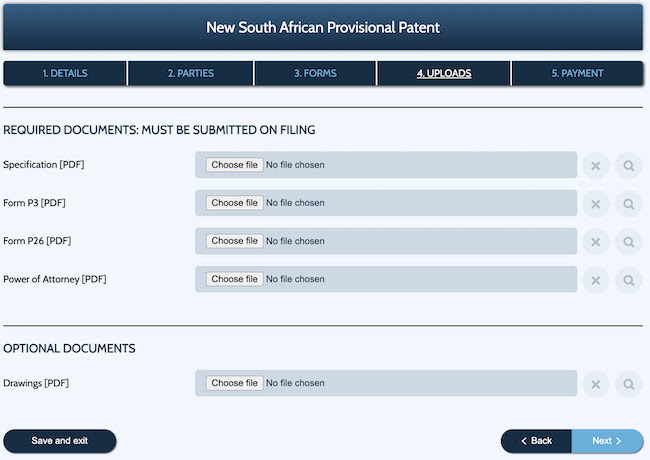
Step 7: Pay by credit card.

That’s it! It really is easy.
PATENT DRAFTING GUIDE
CLAIMS
This section should appear at the end of a patent specification, before the drawings. However, since you should draft this section first, we discuss it upfront.
Furthermore, it is not necessary to include this section in a provisional patent specification, but we suggest that you include it as it focuses the mind on the rest of the specification and forms the basis for the “Summary of the Invention”.
“The Claims” is the most important section of a complete patent as it defines the scope of protection afforded by your complete patent. The claims include:
- independent claims (i.e. claims that stand on their own and do not incorporate features in other claims), which must include one new feature that is considered the most essential and captures the essence of the invention.
- dependent claims, which must introduce one new feature per dependent claim, in decreasing “order of essentiality”.
Notes:
-
- The independent claims do not need to include all the components necessary for the invention to work.
- When introducing a term, refer to “a …”. Only when referring back to a previously defined term use “the …”. Example:
1. A writing instrument comprising / including / having: (select one, but do not use consisting / constituting):
an elongate body defining a central bore;
a writing element sized to fit within the central bore;
an eraser; and
a coupling for connecting the eraser to the elongate body.
-
- Each new feature introduced should first be introduced in broad terms that cover all the possible variants, and thereafter be narrowed down to a specific preferred embodiment in subsequent dependent claims. Example:
2. A writing instrument according to claim 1, further including means for securing the eraser to the coupling and the coupling to the elongate body.
3. A writing instrument according to claim 2, wherein the securing means comprises at least one nail, at least one screw, adhesive or formations to create an interference fit between the parts secured.
-
- When claiming a method, use the following wording:
A method of…, the method comprising the steps of:
(a) …;
(b) …
-
- Ensure all words used in the claims have been used and described in the “Description”.
- Never refer to trademarks in claims – The specification is not a marketing document!
- Draft the claim with the potential infringer in mind. There is no use “catching” users instead of the manufacturer / seller. For example, where a product may be sold in kit form, describe the components and not necessarily the assembled article. Use: “attachable” instead of “attached”, etc.; “an inlet for permitting fluid communication”.
- At the end, consider inserting an “omnibus claim”:
A (writing instrument) substantially as herein described and illustrated with reference to the accompanying drawings. [But do not refer to drawings of “known solutions”]
Tips:
- Create a list of new features and rank them according to essentiality. This list will form the basis of and dictate the order of the claims.
- Always introduce “means” (a general term) as “means for (what it does)”. Thereafter, refer to that feature as “(what it does) means”.
- When referring to more than one, use “a plurality of”.
- When referring to one, consider using “at least one”.
- Do not claim a negative, such as “a hole”, use “a …. defining an aperture”.
Checks:
- Have you included only one new, essential feature in the independent claim and only one additional new feature into each dependent claim?
- Does the independent claim “read onto” “known solutions”?
- Does the claim cover all of your embodiments (including kits)?
- Does the article need to be used for the claim to be infringed?
- Can the claim be designed around using a known alternative?
BACKGROUND
The present invention relates to a (use broad terms, e.g. writing instrument). More particularly, the invention relates to a (describe in more specific terms, e.g. a pencil and eraser combination connected by way of a coupling).
Also:
-
- Describe “known solutions”:
Conventionally, the … (describe known solutions)
-
- Possibly, also discuss “problems” associated with “known solutions”:
A drawback of the above invention is that ..
Note: Do not claim that your invention “solves” problems. Rather use loose terms, such as “addresses”.
DICTIONARY
If you need to define terms, do so as follows:
For the purposes of this specification, the term … shall be taken to include / mean …
SUMMARY OF THE INVENTION
This section should mirror the claims, albeit in language that flows more easily.
According to the present invention there is provided a (writing instrument) comprising:
….; and
…Preferably / typically, the … (feature previously introduced) is a …
The … may comprise / also includes …
If there is more than one unique embodiment:
According to a second aspect / embodiment of the invention, there is provided …
At the end include:
“These and other features, aspects and advantages of the invention will become better understood with reference to the following description and drawings.”
BRIEF DESCRIPTION OF THE DRAWINGS
The invention will now be described in more detail, by way of example only, with reference to the accompanying drawings in which:
Figure 1 shows / is / depicts a (type) view of the invention;
Drawing types:
Plan (top & bottom)
End / side
Perspective
Cross-sectional (along lines 1-1 of Figure X)
Schematic
Exploded (perspective)
DESCRIPTION OF PREFERRED EMBODIMENT
Describe the preferred embodiment of the invention in full. Alternatives can be described in less detail. Do not compare against “known solutions”.
Tips:
- Introduce the main elements of the invention and how they generally co-operate.
- One by one, describe the main elements in detail:
- shape, size, configuration;
- material;
- substitutes / alternatives;
- function; and
- how to make.
- Only describe how the parts interact and how the invention works / is used after the description in the second main bullet point above.
Example:
With reference to figures 2 and 3 of the drawings, the writing instrument 10 includes a pencil 20 and eraser 60 combination, secured together by a coupling 80.
The pencil 20 comprises an elongate body 22 defining a central bore 24. The elongate body 22 … (describe the body in detail, followed by the central bore). The pencil further includes a writing element 40 sized to fit within the central bore 24. The writing element … (describe in detail).
The eraser 60 … (describe the eraser in detail)
The coupling 80 … (describe the coupling in detail)
(Only after each feature has been described in full, do you describe how the components interact)
Additional tips:
- When referring to reference numerals, use even numbers so that features you forgot to include can later be added using odd numbers.
- A second embodiment should start with reference numeral 110, a third with 210, etc.
- To briefly describe variants that you do not wish to illustrate or describe in detail, add the following to the end of the description: “it will be appreciated by persons skilled in the art that the … can be ….”
EXAMPLE: PENCIL-RUBBER
Background
The present invention relates to a writing instrument. More particularly, the invention relates to a pencil-eraser combination, secured together by a coupling.
Known pencil-eraser combinations comprise a pencil having a pin at the non-writing end on which an eraser is secured. A drawback of this arrangement is that the eraser is easily dislodged from the pin and lost.
Summary of the invention
According to the present invention there is provided a writing instrument including:
-
- an elongate body defining a central bore;
-
- a writing element sized to fit within the central bore;
-
- an eraser; and
- a coupling for connecting the eraser to the elongate body.
Preferably, the coupling is cylindrical and sized to receive the elongate body and the eraser at opposite ends.
The writing instrument may further include means for securing the eraser to the coupling and the coupling to the elongate body.
The securing means may comprise at least one nail or screw, adhesive, or formations that create an interference fit between the parts secured.
These and other features, aspects and advantages of the invention will become better understood with reference to the following description and drawings.
Brief description of the drawings
The invention will now be described in more detail, by way of example only, with reference to the accompanying drawings in which:
Figure 1 shows a pencil-eraser combination according to the prior art;
Figure 2 shows a front view of the invention; and
Figure 3 shows a top view of the invention.
Description of the preferred embodiment
With reference to figures 2 and 3 of the drawings, the writing instrument 10 includes a pencil 20 and eraser 60 combination, secured to each other by a coupling 80.
The pencil 20 comprises an elongate body 22 defining a central axial bore 24 that communicates between both ends of the elongate body. The elongate body 22 is cylindrical in cross-section and made from wood.
The pencil further includes a writing element 40 sized to fit within the central bore 24. The writing element 40 is cylindrical and made from graphite.
The eraser 60 is cylindrical, having substantially the same diameter as the elongate body 22.
The coupling 80 is cylindrical having a central axial bore 82 that communicates between both ends of the coupling. The central bore 82 is sized to receive the elongate body 22 at one end and the eraser 60 at the other end and is sized to create an interference fit between the coupling 80 and the eraser 60 and the coupling 80 and the elongate body 22. The coupling 80 is made from tin.
The coupling 80 includes formations 84 extending radially into the central bore 82 for engaging the eraser 60 and elongate body 22 and securing them within its central bore 82.
it will be appreciated by persons skilled in the art that: the elongate body can be polygonal in cross section and can be made from any material, including an elastomeric material; the central bore of the elongate body need not necessarily extend to the non-writing end of the elongate body; the coupling can be made from any material including an elastomeric material; the central bore of the coupling need not necessarily communicate between both ends of the coupling; and the eraser and elongate body may be secured within the coupling using other securing means, including at least one nail or screw or an adhesive.
Claims
1. A writing instrument including:
-
- an elongate body defining a central bore;
-
- a writing element sized to fit within the central bore;
-
- an eraser; and
- a coupling for connecting the eraser to the elongate body.
2. A writing instrument according to any one of the preceding claims wherein the coupling is cylindrical and sized to receive the elongate body and the eraser at opposite ends.
3. A writing instrument according to either of the above claims, further including means for securing the eraser to the coupling and the coupling to the elongate body.
4. A writing instrument according to claim 3, wherein the securing means comprises at least one nail, at least one screw, adhesive or formations to create an interference fit between the parts secured.
Drawings
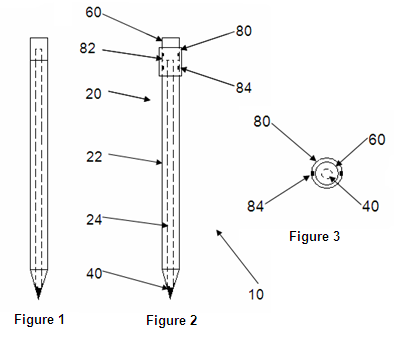
GLOSSARY OF TERMS
RELATIVE POSITION
proximate / distal
proximal
adjacent to
contiguous
adjoining
overlapping
near
radially outwardly / inward
juxtaposed
aligned with
coterminous
superjacent
subjacent
extends transversely
interposed
divergent / convergent
abuts
co-axial
co-planar
CONNECTIONS
connected to
secured to
mounted
attached
engaging
electrically connected
enmeshed (gears)
mated
rotatably fits within
MATERIAL DESCRIPTIONS:
resilient
pliant
flexible
supple
rigid
elastically deformable
PHRASES
sized to fit within …
at least one …
a plurality of ..
formed integrally with …
adjustably secured
releasably attached
pivotally attached
slideably interacting
in fluid communication with
arranged to move
PREFERRED TERMS
to move – actuate
flat – planar
blocking – obturating
move axially back and forth – nutating / reciprocating
receiving means – receptacle
correspondingly shaped – complementally shaped
separated – displaced
rod – elongate member
lever – actuating means
formed with – integral
spring – biasing means
interacts – co-operates
close to – proximate
motor – drive means
casing – housing
screwed – threadably engaged
filling – charging
POSITIONS
operating / resting
locked / unlocked
Movable between a first position in which (describe) and a second position in which (describe)
METHOD
steps in a method:
providing …
supporting …
Installing …
inserting …
removing …
charging …
delivering …
controlling …
maintaining …
applying …
varying …
positioning …
allowing / permitting …
forcing …
exposing …
forming …
bracing …
securing …
moving …
